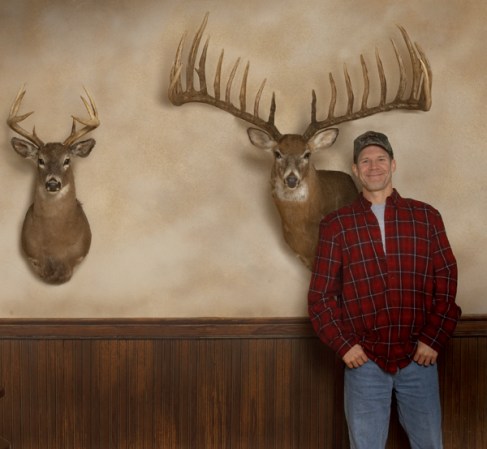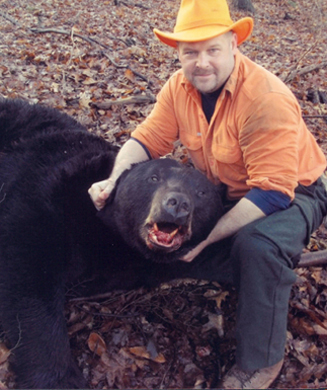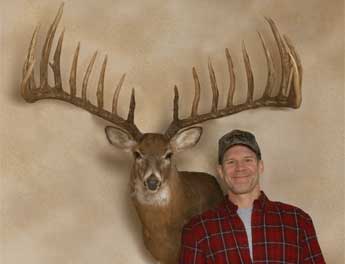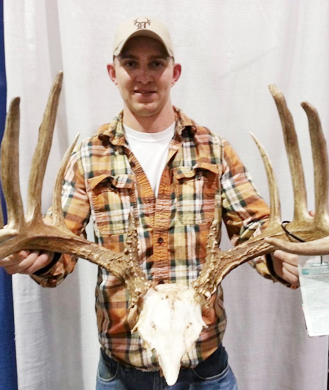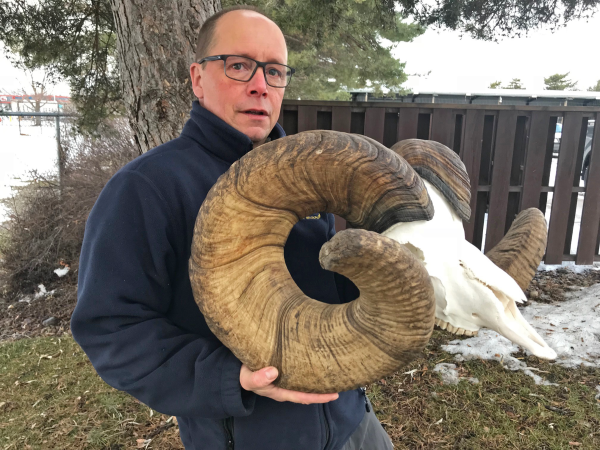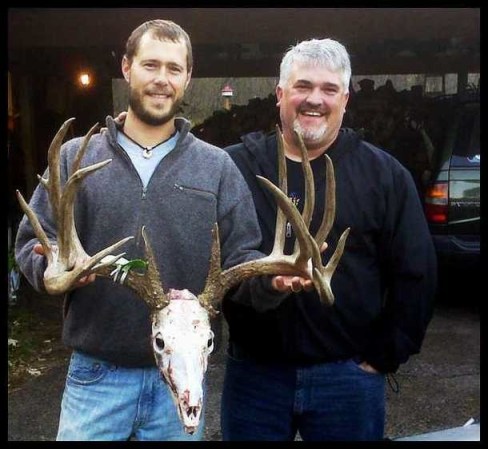As this is being written, what may or may not be the world-record whitetail deer may or may not have been sold to an anonymous collector who may or may not have been the one who bought Mark McGuire’s home-run-record baseball. When Mitch Rompola announced that he had put an arrow into a deer near his northern Michigan home in Traverse City that supposedly scored 2185/8 net, an explosion of interest quickly overwhelmed the reclusive hunter. The photographs he gave to two Michigan newspapers and a couple of television stations showed an animal that was incredible in every sense of that overused word. While Rompola declined to give many details, he admitted the outside spread was 38 inches. The main beams jutted straight out from the sides of the head like the balustrades of a Mississippi mansion. The two biggest tines soared 14 inches, like an elegant bone candelabra, and the sides were so symmetrical they looked almost too perfect.
The rack supposedly netted five inches more than the buck Milo Hanson killed on his farm at Biggar, Saskatchewan, in 1995. The announced green score of 223 fit nicely with Rompola’s statement that it would outdo the Hanson buck “even if you cut off the two five-inch tines” near the ends of the main beams.
But every statement about this deer had to be preceded by modifiers like “supposedly” and “reputedly,” because within a day of killing the deer, Rompola had secreted the antlers away and refused to release a green score. He also announced to this reporter that he hated everything to do with Pope and Young, that he was only slightly less miffed at Boone and Crockett and that “they’re never going to get their hands on it” to score it-a stand he modified to perhaps exclude B&C; once he realized the deer was worth little without that organization’s certification.
In reality, the primary reason for the intensity of the controversy about Rompola’s claims is the Internet, which kindled the firestorm of interest. When Hanson killed his world-record whitetail five years ago, the feat remained a rumor for a few weeks. In contrast, when Rompola told his story and provided a photograph to the Detroit Free Press on November 20, it also went on the Free Press’s Web site and immediately took on a boisterous life of its own. (When Hanson killed his buck in 1995, there was no Free Press Internet site, and about 10 percent as many people were using the net then as are on-line in 1998-99.) In a month, the story was opened and read by some 200,000 Web site visitors; it became the number-one story on the Detroit Free Press Web site for 1998 by several orders of magnitude. Not even major local Michigan stories like the arrest of Dr. Jack Kevorkian on murder charges or the Daimler-Chrysler merger or the weird gubernatorial campaign of Kevorkian’s lawyer came close to drawing such attention.
While there were many who offered congratulations, others found Rom-pola’s story of his November 13 hunt implausible. He would do little to help his cause. As hunters read and argued about the story on the Internet, Rompola changed his telephone number to an unlisted one, retreated into his small home filled with dozens of mounted racks and deer heads on the edge of Traverse City’s South Airport Swamp and largely ignored communications from legions of writers and business people trying to get in touch with him.
Collectors and businesses that wanted to make offers for the rack reported that they were either ignored or told, politely, that Rompola would get back to them-and then ignored. He said in a written statement handed out in early January that he had been overwhelmed by both the friendly and negative reaction to his feat but had decided that “after the 60 days (drying period), it will be measured by several official B&C; measurers. I’m anxiously awaiting that day so speculation can turn to fact, and it’s either the biggest typical or it’s not.”
The se statement solicited bids from the media for what Rompola said were half a dozen aspects of his story that would be written as individual articles. But it also included the enigmatic possibility that “who knows, maybe I’ll stop telling my story and keep it for my own satisfaction.”
Rompola said at one point that sports-show promoters had told him “they don’t care if it’s recognized by P&Y; or B&C; or anybody else, as long as it measures out as the world record.” He also said that he intended to hire a professional agent to handle negotiations with show promoters and companies interested in endorsements. But when the B&C-mandated; 60-day drying period ended, Rompola said, through a friend, that he was not having the deer scored immediately because he was involved in a lawsuit and his close friend was seriously ill. But that stance changed the following week when it was announced the deer had been scored by unidentified measurers.
Supporters have painted Rompola as the consummate deer hunter, a man who lived frugally off his investments and did seminars at sports shows so that he could hunt and study deer in the field 200 days a year. But others came forward to tar his reputation and cast doubt on his feat.
He had once been a measurer for both P&Y; and B&C.; When contacted, a B&C; spokesman said it was up to Rompola to answer questions as to why he was no longer a measurer. A spokesman for P&Y; said that that organization refused to comment on Rompola’s status. People who had hunted with him said they had asked him not to return to their camps, for reasons they wouldn’t disclose.
Meanwhile, wild speculation, rumor and hearsay fueled the flames of interest in lieu of hard information from the hunter. Many people found it odd that no one else had ever seen the “record” deer in an area where summer spotlighting is a virtual family sport, so some speculated it had been pen-raised. Others scoffed that such a deer would be too valuable to kill, and if it was, it would be done by someone who could pay six figures to do so.
A writer’s comment that many hunters were suspicious about the way the ears on Rompola’s deer drooped brought dozens of Internet photos of similarly droopy deer in spontaneous defense of Rompola.
Detractors also found it suspicious that Rompola claimed to have killed approximately 20 P&Y-class; deer in northern Michigan (although he entered only one in the books) while other skilled hunters were hard-pressed to kill two or three over their careers. But Rompola’s friends countered that this only served to prove that Mitch was simply the best hunter who had ever lived in the state-and besides, hunting was all he did.
Grand Traverse County is not known for producing giant racks. Yet Rompola told people that not only had he been hunting this huge buck for three years, but he knew of several others in the area that would make the B&C; book, and perhaps one that would equal his claimed record kill.
Many found Rompola’s secretiveness after the fact harder to understand, especially when it seemed counterproductive to his stated aim (in a written statement a “friend” of his handed out) of exploiting the rack financially. Rompola had been alone when he killed his deer, but such is the case with many successful hunters in this often solitary pursuit. What was unusual was that he went home after killing what he should have been well aware might be a world record at 7:48 a.m., had breakfast, got his video camera and then went back to find his record deer (even though he said to newspapermen, and on television, that from his tree stand he heard it fall after it ran about 70 yards).
Even odder was his claim that he then spent nearly five hours hauling out of the woods by himself an animal that field-dressed at 263 pounds. But once again his supporters shrug that off as “just Mitch,” a guy so secretive it’s doubtful he would let his mother see his hunting spots.
By the third week of January, interest in Rompola and his deer reached a fever pitch nationwide, and he announced that it had been scored by not one but four B&C; certified measurers. However, he did not name them, and one of Rompola’s friends implied that the scorers had been sworn to secrecy and flown in from out of state by a collector interested in buying the rack. Again, while Rompola wasn’t talking directly, people who talked for him said that he was close to finalizing a sale to a wealthy collector, and one source indicated that the buyer might be the same person who paid $2.7 million for Mark McGuire’s 70th home-run ball.
As of this writing, Rompola had not submitted any score sheets to B&C;, as that organization requires. And well-known B&C; measurers in Michigan and elsewhere were bewildered by the fact that no one had come forward to say they had participated in the scoring. Ron Boucher of Wallingford, Vt., a prominent B&C; measurer (and occasional contributor to this magazine) scored Hanson’s buck. He said, “Even if (Rompola) kept the score sheets, all B&C; measurers are required to fill out a 3-by-5 card stating they measured an animal of a given species and sex at such-and-such a time on a certain date and mail it in immediately. B&C; records the date the card arrives, and that’s the only score accepted. (his procedure) is to keep people from going to three or four measurers, shopping for one who will give them a better score.” At press time, Jack Reneau at the B&C; office in Missoula, Mont., confirmed that the organization had received neither score sheets nor a postcard confirming the deer had been measured.
Hunters are suspicious of record-deer claims because there have been many fakes and hoaxes in the past, sometimes by people trying to make money from those who would pay the hunter to endorse everything from bows to vehicles.
Supporters say proof of Rompola’s claims can be found in what he maintains are photographs of the big deer that he took live in the woods, and which he had been showing to people for three years. The pictures show impressive racks and parts of the animal’s body, always well screened by branches. But such photos could possibly have been created with a mounted deer head, or a full- body mount, like the one Rompola has sitting in his living room.
Rompola has told friends he hopes the controversy will die down and go away. But until B&C; announces that it has accepted the deer as real, that wish is about as likely as someone killing another 218 5/8.
see his hunting spots.
By the third week of January, interest in Rompola and his deer reached a fever pitch nationwide, and he announced that it had been scored by not one but four B&C; certified measurers. However, he did not name them, and one of Rompola’s friends implied that the scorers had been sworn to secrecy and flown in from out of state by a collector interested in buying the rack. Again, while Rompola wasn’t talking directly, people who talked for him said that he was close to finalizing a sale to a wealthy collector, and one source indicated that the buyer might be the same person who paid $2.7 million for Mark McGuire’s 70th home-run ball.
As of this writing, Rompola had not submitted any score sheets to B&C;, as that organization requires. And well-known B&C; measurers in Michigan and elsewhere were bewildered by the fact that no one had come forward to say they had participated in the scoring. Ron Boucher of Wallingford, Vt., a prominent B&C; measurer (and occasional contributor to this magazine) scored Hanson’s buck. He said, “Even if (Rompola) kept the score sheets, all B&C; measurers are required to fill out a 3-by-5 card stating they measured an animal of a given species and sex at such-and-such a time on a certain date and mail it in immediately. B&C; records the date the card arrives, and that’s the only score accepted. (his procedure) is to keep people from going to three or four measurers, shopping for one who will give them a better score.” At press time, Jack Reneau at the B&C; office in Missoula, Mont., confirmed that the organization had received neither score sheets nor a postcard confirming the deer had been measured.
Hunters are suspicious of record-deer claims because there have been many fakes and hoaxes in the past, sometimes by people trying to make money from those who would pay the hunter to endorse everything from bows to vehicles.
Supporters say proof of Rompola’s claims can be found in what he maintains are photographs of the big deer that he took live in the woods, and which he had been showing to people for three years. The pictures show impressive racks and parts of the animal’s body, always well screened by branches. But such photos could possibly have been created with a mounted deer head, or a full- body mount, like the one Rompola has sitting in his living room.
Rompola has told friends he hopes the controversy will die down and go away. But until B&C; announces that it has accepted the deer as real, that wish is about as likely as someone killing another 218 5/8.

